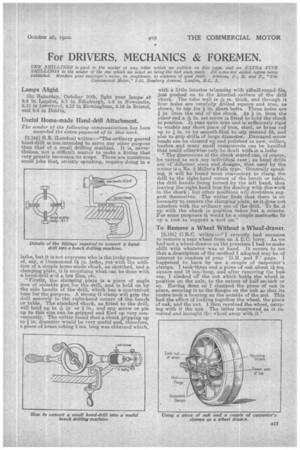For DRIVERS, MECHANICS & FOREMEN.
Page 29

If you've noticed an error in this article please click here to report it so we can fix it.
TEN SHILLINGS is paid to the sender of any letter which we publish on this page, and an EXPIIA. FIVE SHILLINGS to the sender of the one which we select as being the best each week. All notes are edited before being published. Mention your employers name, in confidence; as evidence of good faith. Address, D., M. and F., "The Oommercial Motor," 7-15, Rosebery Avenue, London, B.C. I.
Lamps Alight
On Satufday, October 301h, light your lamps at 5.6 in London, 5.7 in Edinburgh, 5.2 in Newcastle, 5.13 in trvernool, 5,12 ha Birmingham, 5.16 in Bristol, and 6.6 in Dublin.
Useful Home7made Hand-drill Attachment,
The sender of the following communication has been awarded the extra payment of 58 this-week.
(2,150] H.B. (London) writes :—"The ordinary geared hand-drill is not intended to serve any other purpose than that of a small drilling machine. It is, nevertheless, not a difficult matter to make a fitting that very greatly increases its Scope. There are numerous small jobs that strictly speaking, require doing in a
lathe, but it is net everyone who is the lucky possessor of, say, a Drummond 34 in. lathe, yet with the addition of a simple home-made chuck, as sketched, and a, clamping plate, it is surprising what can be done with a hand-drill aaid a few files, etc. "Firstly, the clamping plate is a piece of angle iron of suitable lize for the drill, and is held on by the side handle of the drill, which has a -convenient boss for the purpose. A strong G clamp will grip the drill securely to the right-hand corner of the bench or table. The standard chuck, as fitted to the drill, will hold up to -fle, in or in.' and any screw or pin up to this size can be gripped and filed up very conveniently. • The writer found that a, chuck gripping up to in. diameter would be very useful and, therefore, a piece of brass tubing 3 ins, long was obtained. which,
with a little interior trimming with abalf-round file, just pushed on to the _knurled surface of the drill chuck. The tube wall is in. thick, and through it four holes are carefully gilled square and true, as shown, to tap for in. short bolts. These holes are in. from the end of the chuck. At in. from the other end a. in. set screw is fitted to hold the chuck in position. It runs quite true and is sufficiently rigid to enable any short piece of iron, steel, or brass rod up to in. to be, smooth-filed to any desired fit, and also to grip drills of large diameter.. ,Damaged screw heads can be cleaned up and polished as new,' collars, bushes and many small components can be handled that could otherwise. only.be dealt with, in a lathe
"The dimensions of the chuck stated can, of course, be varied to suit any individual case as hand drills are of-different sizes and /designs, that used by the writer is a No. 2 Miller's Falls type. Generally -speaking, it will be found most convenient to clamp the drill to the right-hand corner of the bench or table, the drill handle being turned by the left hand, thus leaving the right hand free for dealing with.theo work in the chuck ; but other positions will doubtless suggest themselves. The writer finds that there is no necessity`to remove the clamping plate, omit does not interfere with the ordinary use, of the drill. To fix it up with the chuck in position takes but a minute. For some purposes it would be a simple mattereto fla up a rest to support a -tool on."
To Remove a Wheel Without a Wheel-drawer.
[2,151J 0.110. writes:—" I recently had occasion to remove a rear wheel from an A.E.C. lorry. As we had not a, wheel-drawer on the premises I had to make shift with whatever was at hand. It occurs to me that a description of the method I adopted may be of interest to readers of your D.M. and F.' page. I happened to have by me a couple of carpenter's clamps. I tooktliese and a piece of oak about 1 ins. square and 18 ins, long, and after removing the hub cap, I slacked off the nut which holds the wheel in position on the axle, to the extent of half-an-inch or so. Having done so I clamped the piece of oak in. place, securing it to the flanges on the hub so that its centre took a bearing on the outside of the nut. This had the effect of locking together the wheel, the piece of oak, and the nut,. I then revolved the wheel, carrying -with it the nut. The latter unscrewed as it revolved and brought the wheel away with it."




























































